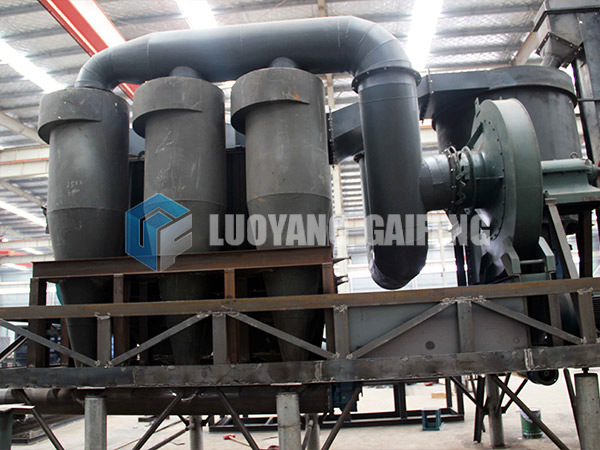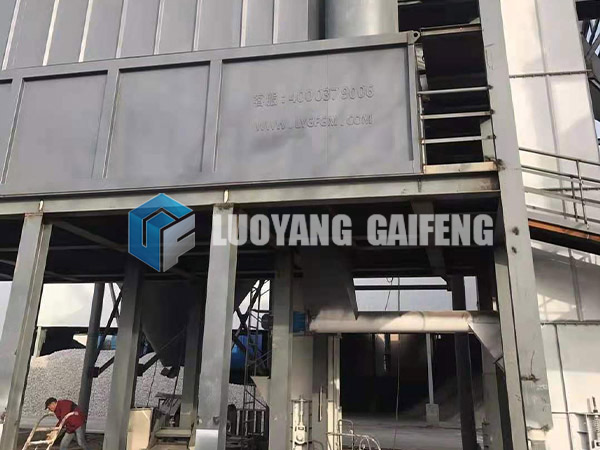What is the difference between calcium hydroxide equipment and traditional production processes?
Crush the qualified calcium oxide (CaO) block material from the jaw crusher to a particle size of about 40mm, and transport it to the calcium oxide storage tank warehouse through a bucket elevator. The calcium oxide in the warehouse enters through the quantitative stabilization system of the steady flow conveyor The calcium hydroxide grade I digester performs preliminary digestion. After the calcium hydroxide completes the primary digestion, it enters the ii digestion or iii digestion device. The calcium oxide is completely digested and decomposed. The calcium hydroxide that is digested and decomposed by the qualified calcium hydroxide primary product is spiraled by the semi-finished product. The conveyor is transported to the pulverizer, and the pulverizer completes product impurity separation and fineness classification. After the classification is completed, the terminal qualified high-quality products are unloaded by the finished product conveyor and elevator to the finished calcium hydroxide tank for packaging respectively. All pollution nodes of the production line are completed by pulse dust collectors, with a dust removal rate of 99.5%.
The difference between calcium hydroxide equipment and traditional production technology

Advantage 1:
In China, the production process of calcium hydroxide is still dominated by handcrafted workshops. There are only a handful of calcium hydroxide manufacturers capable of mechanization and large-scale production. The calcium hydroxide produced in the manual workshop is mainly used in low-end markets such as sewage treatment, ash calcium, and putty powder. The production process and product quality have the following problems:
(1) Severe environmental pollution: Due to manual production, large amounts of high-temperature steam and dust generated during the digestion process are everywhere, and the dust pollution radius is at least 1,000 meters. The forests and crops within the contaminated area are seriously damaged and often cause disputes between the public and enterprises around the enterprise.
(2) In the past, the intensity was high and the scale was small: the production environment of such enterprises was extremely poor, and the labor intensity of workers was extremely high, which seriously affected the physical and mental health of production workers. The production efficiency is extremely low, no more than 1 ton of finished calcium hydroxide per person during the day. Although there are a large number of such enterprises, their scale is small, with an annual output of 5,000 tons and an annual output of several hundred tons. The production capacity cannot meet the large demand for calcium hydroxide in power plants, such as desulfurization, fine chemicals, medicine and food, petroleum, papermaking and other industries.
(3) The product quality is poor and unstable: Because it is produced manually, the production process depends on experience. The quality of the final product varies from time to time, which cannot meet the needs of petrochemical, fine chemical and other industries.
With the rapid expansion of the calcium hydroxide market, customers’ improvement in product quality, and the country’s emphasis on the environment, the calcium hydroxide market has given birth to a number of large-scale, highly mechanized production companies that meet national environmental protection requirements and have stable quality. . Meet market demand, reduce environmental pollution, improve the production environment of workers, and reduce labor intensity of workers.
In this context, GF, GFD, and GAD calcium hydroxide equipment has realized fully automatic control and online real-time inspection. The complete production line fully meets the requirements of the national environmental protection department, and the product fineness ranges from 200 to 600 mesh. The output of a single machine varies from 3T/h to 20T/h, and different schemes can be completed according to user requirements. The product quality fully meets industry requirements.

Advantage 2:
1. Inspection system:
Electronic means are used for rigid inspections, and inspectors sample unit time to ensure stable product quality and avoid quality problems caused by deviations in raw material production.
Electronic means are used for rigid assessment, and equipment maintenance personnel conduct inspections on the operation cycle of each part, so that problems can be solved in time when problems are found, and the equipment will be prevented from running with failures, thereby prolonging the service life of the equipment.
Using electronic hard inspection method, each operating part is lubricated to avoid oil-free operation and accidental wear.
2. On-site remote control
The equipment is remotely switched on and off in all parts of the equipment production area to deal with emergencies and avoid personnel and financial losses.
3. Discharge temperature
The discharge temperature is controlled at about 45°C, and the discharge water content is controlled at about 1%. Prevent agglomeration of the finished product, improve the efficiency of powder selection and waste discharge.
The above is all about the difference between the calcium hydroxide equipment and the traditional production process. If you encounter any problems in the operation of the calcium hydroxide equipment, you can contact us at any time. As a professional calcium hydroxide equipment manufacturer, we look forward to your consultation .


